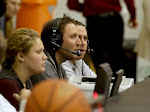NCAA tournament expanding to 68 -- not 96 -- teams
As I wrote earlier this month, expanding to 96 teams could have had dire consequences down the road. With that in mind, I'm joining the halleluja chorus of media and fans celebrating today's decision.
Here's the AP story on the official move and some more details about the tournament's new TV deal with CBS and Turner:
NDIANAPOLIS (AP) — The road to the Final Four will have a new look next season.
On Thursday, the NCAA's board of directors approved expansion from 65 to 68 teams and endorsed a proposal to add three more opening-round games to the schedule. It's only the second time in a quarter-century that the NCAA has increased the number of teams competing for the men's national championship.
Now it's time to start mapping out the details, which could include putting at-large teams in the early games.
"The (men's basketball) committee will have to study any variety of options and certainly the notion of looking at options involving the last at-large teams in would be one possible option," NCAA vice president Greg Shaheen told The Associated Press. "We would expect the committee to examine all of the options."
The decision was not a surprise.
NCAA officials recommended the 68-team field last week after the public loudly complained that going to 80 or 96 teams would water down the NCAA's marquee event, and network executives insisted they did not need more tourney games to make a profit on the next television contract.
So the NCAA backed the most modest expansion, at least for now. The board gave unanimous consent to the 68-team field with a caveat — it wants the "play-in" games to have more significance.
"Expanding to 68 teams gave us an opportunity to involve more teams in the championship, and in doing that, we were able to enhance the experience of the opening-round game," Clemson president James Barker, the committee chairman, said in a statement.
It's the first time since 2001, when the NCAA added one team to the 64-team team field that it has expanded. The NCAA went from 48 to 64 teams in 1985.
More teams won't be the only change fans see next March.
Thanks to the new 14-year, $10.8 billion television package with CBS and Turner Broadcasting, also announced last week, fans can choose which games they want to watch. It will be the first time every tourney game will be televised live nationally. One game will be carried by CBS, with others carried on TNT, TBS and truTV.
It's a smaller overhaul than fans expected after NCAA officials spoke extensively about the format for a 96-team field four weeks ago, but it hasn't stopped the talk about additional expansion.
The new TV deal gives the NCAA sole authority to expand again, a possibility some observers believe will happen in the near future. Don't bet on it.
"Field size of any event is something people like to debate, but it's not something the committee is interested in taking on in the foreseeable future," Shaheen said.
Tourney expansion was only part of the board's busy schedule Thursday.
It also endorsed a recommendation that would require football players to complete nine credit hours during the fall semester to be eligible for the following season. And the Committee on Academic Performance wants to eliminate waivers for Football Bowl Subdivision teams that lose players who are academically ineligible after completing their eligibility. The board believes the elimination of those waivers will force schools to place greater emphasis on retaining athletes.
Both proposals are expected to be added to the 2010-11 legislative calendar.
Other discussion topics on the board's agenda included the use of athletes' names, images and likenesses in commercial products; new rules for handling athlete concussions; and tougher academic standards for junior college transfers. The NCAA did not immediately give any indication of what the board did on those issues.
As usual, though, the men's basketball tourney stole the show.
"The basketball committee very intensely got into determining the tournament structure in the last two years, so it's been an extensive journey," Shaheen said. "But we also recognize it's just one of the 88 championships, so we've still got a lot of work to do. We still have a significant amount of (television) rights to work on."
 RSS
RSS


0 Comments:
Post a Comment
Subscribe to Post Comments [Atom]
<< Home